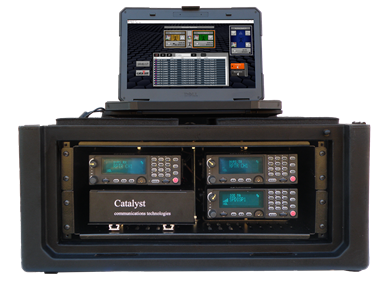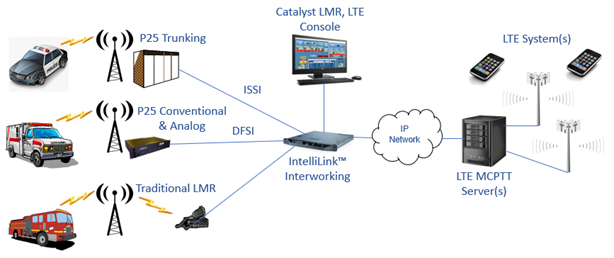Catalyst is the first company other than L3Harris to demonstrate advanced control of new multiband, multimode radio
Catalyst will demonstrate some of the most advanced technology in support of Public Safety Communications available anywhere when first responders, dispatchers, and other public safety professionals descend on Las Vegas for IWCE 2021 this week. Go Kits, ICE™, the L3Harris XL-200M integration, Interloc™ Location Services now with LTE Smartphone tracking, IntelliLink™ Interworking and other innovations from the leader in Dispatch, Interoperability, Interworking and Incident Command for the critical communications marketplace will be on display.
L3Harris XL-200M mobile radio integration -Dispatch, Interoperability, Interworking and Incident Command
The L3Harris XL-200M is unique in the marketplace due to its wide variety of network and communications capabilities. The XL-200M is a multiband radio supporting VHF, UHF, 700/800 and 900 MHz bands, and includes built-in Wi-Fi®, Bluetooth® and GPS. The radio features an intuitive interface and high-visibility color display, allowing users to stay more focused on the job, and its optional LTE capabilities provide an on-the-go communications hub, providing hotspot capabilities that allow you to stay connected to an LMR or LTE network.

With advanced control of this radio from Catalyst, dispatchers using Catalyst’s Propulsion dispatch console can change channels and talk groups, display, declare and clear emergency indications, display unit ID’s and aliases, and execute other control functions. The advanced interface provides a wealth of real-time operational data that is available for display to dispatchers as well as programming information that facilitates system administration and maintenance.
The XL-200M is the latest addition to Catalyst’s Dispatch Radio Control over IP solutions, including new configurations of ICE™ – Incident Commander Element – which provides transportable incident command and digital vehicular repeater solutions to the mission critical marketplace. ICE™ packages two to four mobile radios, Radio Control Software, Dispatch Software, and Interoperability Software into a single unit.

ICE™ is receiving strong market acceptance. When Firefighters enter a burning building, they often choose “direct mode,” as in-building coverage may be limited. However, these communications have traditionally not been routed back to the Dispatcher, hampering coordination. ICE™ relays the in-building direct mode communications back to the Dispatcher and provides a number of valuable ancillary capabilities including Incident Command, recorded audio conversations, and on-scene logging of unit IDs and Emergency messages.
LMR LTE INTERWORKING-technology to support Mission Critical Push to Talk Applications on Smartphones
Among the leading technology on display is Catalyst’s IntelliLink™ Interworking, now deployed in field trials and providing communications between portable radio users and smartphones with standards-compliant Mission Critical Push to Talk applications. This advanced Interworking solution maps multiple talk groups on LTE Networks and LMR Networks to each other and provides advanced communications capabilities, including a public safety grade dispatch console that displays unit ID, Emergency Indication, and Location for both LMR and LTE subscribers; capabilities that are not available in voice only Radio over IP (RoIP) solutions.
Competing RoIP solutions typically only provide a basic analog interface between LMR radios and LTE Networks, with some fundamental shortcomings such as not being able to detect whether the attached donor radio is turned on and operating. In contrast, the Catalyst IntelliLink™ Interworking solution interfaces with a wide variety of standards-based as well as proprietary LMR radio systems, providing advanced control of these networks through Catalyst’s Radio Control over Internet Protocol technology. Depending on the radio, IntelliLink™ Interworking monitors the radio status and, if busy, can store the audio until the radio channel is free, key up the radio automatically and transmit the call, so that no syllables or words are lost during the communications. Catalyst technology also records all the communications including meta data like Unit ID from both LMR and LTE networks for later playback and review. Catalyst LMR radio interfaces include P25 CSSI/ISSI, P25 DFSI, DMR AIS, as well as intelligent interfaces to radios such as L3Harris and Kenwood. Catalyst can, of course, also provide legacy Tone and DC control solutions common to older radio systems.

Research and development of the IntelliLink™ Interworking suite of capabilities was initially funded through a contract with the Department of Homeland Security (DHS) Science and Technology Directorate. More recently, however, Catalyst was awarded a three-million-dollar grant to commercialize this technology from the Department of Commerce (DOC) Public Safety Communications Research Division (PSCR), a Division of the National Institute of Standards and Technology (NIST).
Location Aware from LTE Devices: InterLoc™ support for Smartphones with 3GPP Compliant Mission Critical Push to Talk Applications
Also at IWCE 2021 is the announcement that InterLoc™, Catalyst’s location services for mission critical radio networks, now acquires and presents the GPS location of individuals with MCPTT applications on Smartphones connected to these LTE networks. Maps display and differentiate between various LMR and LTE users with distinctive graphics The InterLoc™ system from Catalyst is unique because it does not require expensive map licensing or cellular data charges for LMR devices, making the system very cost-effective compared to typical AVL solutions. InterLoc™ is seamlessly integrated with Catalyst’s Dispatch and Interoperability solutions, and Dispatchers can initiate text and voice communications to individual users directly from the map. Maps can display subscriber status (such as Emergency), and Dispatchers can center the map on any resource with the click of a mouse. Multiple maps, and multiple types of maps, can be simultaneously displayed, and a robust tool-kit provides map customizations that help Dispatchers to better manage critical communications resources.

Innovations in Hardware Platforms – Catalyst Go Kits
Dispatchers sometimes need to move from their primary Dispatch facilities and continue critical Dispatch operations. Some typical scenarios are:
- Covid – 19
- Mold Removal from the Building
- Fire, Water or other Damage
Catalyst is demonstrating our Go Kits, a transportable Dispatch solution that’s part of the Catalyst Dispatch Solutions family. Go Kits augment your existing Catalyst Dispatch System with a low cost, easily deployed backup for emergencies when Dispatchers need to relocate.
Go Kits include computer hardware, accessories for a fully functional dispatch position, and a hardened enclosure. Propulsion™ Dispatch Software can be optionally added as can Cradlepoint Wireless Wide Area Network devices. Transmitting over LTE, Go Kits can be located anywhere in LTE cellular coverage and can connect to Catalyst Gateways through a variety of backhaul solutions.

Catalyst Executives making an impact at IWCE
Also at IWCE, Catalyst introduces its newest member of the Executive Team James Teel, Vice President of Business Development. James brings extensive experience leading communications technology business development and product management organizations in the public safety marketplace. Prior to Catalyst, James spent more than 14 years at L3Harris (formerly Harris) and was instrumental in positioning the company as an early market leader in the emerging FirstNet/Nationwide Public Safety Broadband Network. Speaking about James, Robin Grier said “James has been an A List business manager his entire career and we’re excited to have him on our team. Catalyst has significant opportunities to grow as the mission critical marketplace embraces LTE technologies and James’ skills and experiences will be instrumental as we roll out our LMR/LTE Intellilink™ Interworking solutions.”
And, speaking of Robin Grier, he’ll be presenting at IWCE as part of the Project 25 Interest Group (PTIG) presentation “Harmony for Future for PTT Services? P25 and LTE”. Robin’s talk will focus on LMR LTE Interworking, and attendees can attend this presentation Wednesday, September 29 from 4:30pm – 5:45pm.

